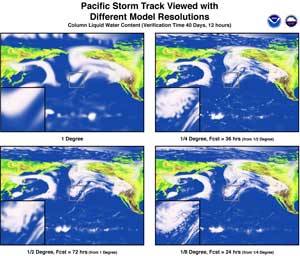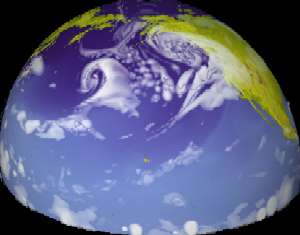Visualizations - Mesoscale Dynamics
Mesoscale Circulation Modeling
A stand alone explicit convection ZETAC model simulation was done for
the globe with an astonishing averaged grid resolution of about 10-12
km. To compare the resolution of these cases with present GMCM's
(Global Mesoscale Circulation Models), it's better than an N770 or a
spectral T1400. This 24 hour high-resolution experiment (TERRA HRG_a) is
visualized below, in addition to lower resolution experiments that have
been simulated for up to 80 days total (TERRA HRG_00).
Limited region experiments applicable to Pacific Storm Tracking are also presented below.
|

|
Title |
TERRA HRG_a |
| Description |
|
| Model name |
n/a |
| Scientist(s) |
Isidoro Orlanski
Steve Garner
Christopher Kerr |
| Date created |
July 2003
|
| Visualization Personnel |
Remik Ziemlinski |
| Files |
Tiff (30 MB)
1/8 Degree Avi (3.2 MB)
Flash
Png (701 KB)
|
|

|
Title |
TERRA HRG_00 |
| Description |
|
| Model name |
n/a |
| Scientist(s) |
Isidoro Orlanski
Steve Garner
Christopher Kerr |
| Date created |
July 2003
|
| Visualization Personnel |
Remik Ziemlinski |
| Files |
1 Degree Avi (3.2 MB)
½ Degree Avi (1 MB)
¼Â Degree Avi (1.3 MB)
Flash
Png (742 KB)
|
|

|
Title |
TERRA HRG_a |
| Description |
|
| Model name |
n/a |
| Scientist(s) |
Isidoro Orlanski
Steve Garner
Christopher Kerr |
| Date created |
July 2003
|
| Visualization Personnel |
Remik Ziemlinski |
| Files |
1/425 Degree Avi (2.7 MB)
1/8.5 Degree Avi (4.5 MB)
Flash
Png (1.1 MB)
|
Cyclones and Storms
|

|
Title |
Pacific Storm Track
|
| Description |
Developed at GFDL, ZETANC is a high resolution, non-hydrostatic,
fully compressible model of hemispheric extent. The model is being used
for the simulation of the detailed structure of extra-tropical storms and
storm tracks. The studies are aimed in particular at a more definitive
understanding of the effects of moist convection on storm structure and
evolution. These simulations will be used to evaluate parameterizations
in global climate models. The model will also will be used to study the
seasonal cycle and inter-annual variability of the storm tracks and their
sensitivity to climate change, placing particular emphasis on extreme
extra-tropical weather. ZETANC could be used to simulate phenomena at
any meteorological scale since it does not require the standard restricted
assumptions. In order to illustrate the versatility of the model, two
extreme experiments are shown: a) Bubble convection in an isentropic
environment, and b) the life-cycle of baroclinic eddies.
|
| Model name |
n/a |
| Scientist(s) |
n/a |
| Date created |
n/a |
| Visualization Personnel |
n/a |
| Files |
|
|

|
Title |
Liquid Water
|
| Description |
The eddy activity along the storm track has been simulated without
the standard moist parameterizations. Actual individual clouds are
explicitly resolved in these runs using explicit moist convection
in the non hydrostatic compressible hemispheric model ZETANC. The
animation shows only a very small portion of the total integration.
The integrated column of liquid water is shown in gray.
|
| Model name |
n/a |
| Scientist(s) |
n/a |
| Date created |
n/a |
| Visualization Personnel |
n/a |
| Files |
|






